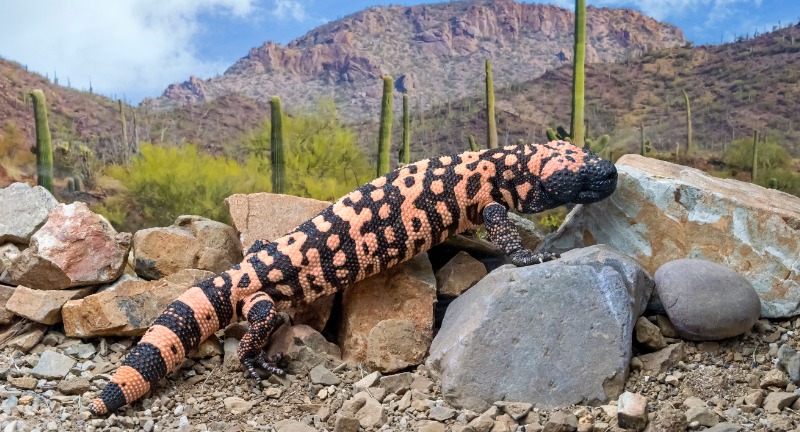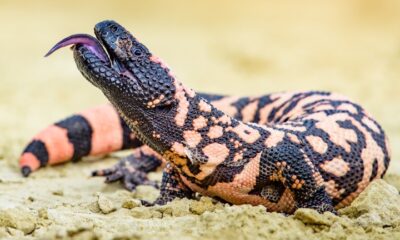NEWS
15 Things to Know About the Mysterious Gila Monster
Published
3 months agoon

Shutterstock
With vibrant patterns and a venomous reputation, the Gila Monster is one of the most fascinating creatures of the desert. As a slow-moving yet resilient predator, it commands attention in the arid landscapes of the American Southwest and Mexico. Despite its fearsome appearance, this lizard is far from aggressive, preferring a solitary life underground when not hunting for prey.
Let’s take a look at interesting facts about the Gila Monster, a symbol of survival and mystery in some of the planet’s harshest environments.
Venomous but Non-Aggressive

Shutterstock
While Gila monsters are one of the few venomous lizards in the world, they are far from the aggressive predators some might imagine. These reptiles are reclusive and prefer to avoid encounters with humans or larger animals. Their venom is primarily a defensive mechanism rather than a hunting tool. Despite their fearsome reputation, they pose little risk as long as they’re left undisturbed.
Named After the Gila River

Shutterstock
The name “Gila monster” originates from the Gila River Basin, a vast and arid region where these creatures were first identified. This area spans parts of Arizona and New Mexico, their primary habitat. The lizard’s name is a nod to its environmental roots, highlighting its connection to the Southwest. Despite their name, they are found in a variety of deserts beyond the Gila River.
Bright and Bold Appearance

Shutterstock
Gila monsters are nature’s way of combining beauty and survival. Their vibrant black, pink, and orange patterns not only make them visually striking but also serve as a warning to predators. This coloration is an example of aposematism, where bright colors signal danger or toxicity. It’s a clear message: “Don’t mess with me!”
Venom Delivered by Teeth, Not Fangs

Shutterstock
Unlike snakes, Gila monsters don’t rely on hollow fangs to deliver their venom. Instead, their venom flows through grooves in their lower teeth as they chew into their prey or a would-be attacker. This slow-release method is less dramatic than a snake bite but no less effective. It ensures that their venom is absorbed gradually, causing significant pain and discomfort.
A Lethal but Beneficial Bite

Shutterstock
Though painful, the venom of the Gila monster has a silver lining. Scientists discovered that it contains a compound instrumental in developing drugs like exenatide, used to treat type 2 diabetes. This compound helps regulate blood sugar levels by mimicking a hormone that stimulates insulin production. Nature’s “monsters” often hold keys to medical breakthroughs.
Not Deadly to Humans

Shutterstock
Despite myths of Gila monsters being lethal, their bites are rarely fatal to humans. The pain and swelling caused by their venom can be severe but are unlikely to cause death with modern medical care. Most bites occur when humans handle or provoke these creatures, so the best precaution is simply to observe from a distance. Their fearsome reputation is largely undeserved.
Unique Skin Texture

Shutterstock
A Gila monster’s skin is unlike most other reptiles. It is covered in small, bead-like scales called osteoderms, which are bony deposits embedded in the skin. This texture not only gives them their distinctive appearance but also provides protection against predators and harsh environmental conditions. Their tough skin is a perfect adaptation to the rugged desert landscape.
Desert Dwellers

Shutterstock
Gila monsters are perfectly suited to the desert environment. They inhabit arid regions with sparse vegetation, where temperatures can soar during the day and plummet at night. Their ability to adapt to extreme conditions allows them to thrive where few other creatures can survive. Their role in these ecosystems is vital, as both predator and prey.
Excellent Climbers

Shutterstock
Despite their stocky bodies and slow pace, Gila monsters are surprisingly adept climbers. They use their strong limbs and claws to scale rocky surfaces and even trees. This climbing ability helps them access bird nests or escape predators. It’s a skill not often associated with such bulky reptiles but essential for their survival.
Slow and Deliberate

Shutterstock
Gila monsters may be slow movers, but this doesn’t mean they’re lazy. Their deliberate pace is a survival strategy, conserving energy in their harsh desert habitats. When necessary, they can move quickly, such as when capturing prey or evading danger. Their measured movements are a hallmark of their efficient and calculated nature.
Hunger Storage in the Tail

Shutterstock
A Gila monster’s tail is not just for balance—it’s a survival tool. They store fat in their tails, which can sustain them during food shortages. This adaptation allows them to survive for months without eating. In the harsh desert, this ability to endure scarcity is crucial.
Long Lives

Shutterstock
Gila monsters are among the longest-living reptiles in North America. In the wild, they can live up to 20 years, and some in captivity exceed 30 years. Their long lifespan is partly due to their slow metabolism and reclusive nature. Their longevity makes them even more fascinating and valuable to researchers.
Solitary Creatures

Shutterstock
These lizards are not social animals. Gila monsters spend most of their lives alone, interacting with others only during the mating season. This solitary nature helps reduce competition for food and burrows. It’s an effective strategy for survival in the sparse desert environment.
Remarkable Burrowers

Shutterstock
Gila monsters are skilled at digging burrows to escape predators and extreme temperatures. They often take over abandoned burrows from other animals, modifying them to suit their needs. These burrows are critical for their survival, providing a safe haven in an unforgiving habitat. Their digging skills highlight their adaptability.
Seasonal Activity

Shutterstock
Gila monsters are most active during spring and early summer. During the hottest parts of the year, they retreat to their burrows to avoid extreme heat. Their seasonal activity patterns align with the availability of food, such as eggs during the bird nesting season. Timing is everything for these desert dwellers.
Conclusion

Shutterstock
The Gila monster is a remarkable example of nature’s ingenuity, blending beauty, mystery, and resilience. Its adaptations, from venomous defenses to fat-storing tails, make it a master of survival in the unforgiving desert. Beyond its ecological role, the Gila monster has left a profound impact on science and medicine, proving its value extends far beyond its striking appearance. By understanding and protecting these unique creatures, we honor the delicate balance of the ecosystems they call home.
More Amazing Animals+
-


24 Ways Hippos Are Even Cooler Than You Thought
-


25 Reasons to Choose the Chow Chow as Your Pet
-


25 Reasons Why Pekingese Are the Most Regal Lap Dogs
-


More – Alligator arrest outside of a school in Charleston,…
-


25 Lovable Traits of the English Springer Spaniel
-


Aerial footage of shark-infested waters in Pasco County, FL
-


25 Reasons Why West Highland Terriers Are Perfect Family Pets
-


25 Iconic Animals of the African Safari
-


17 of the Rarest Creatures in Australia
-


19 Wolf Facts That Show Why They’re Legends of the…
-


23 Animals That Thrive in Desert Climates
-


25 Fun Facts About Wirehaired Pointing Griffons You’ll Love
